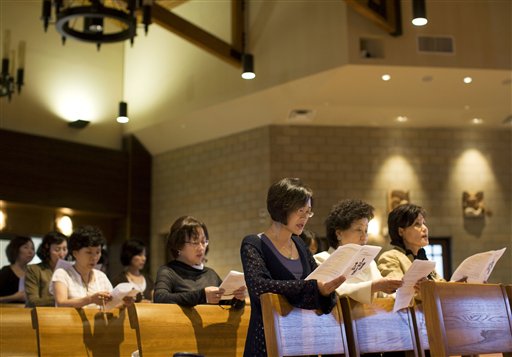ANAHEIM, Calif. (AP) — A fan-shaped baptismal font lies beneath a prominent chandelier, the centerpiece to a new worship center where priests hope to further expand one of the nation’s largest Korean Catholic congregations.
St. Thomas Korean Catholic Center of Anaheim and other Korean Catholic centers have seen their pews fill up in recent years, aided by a surge in immigration to affluent Orange County and a steady stream of converts who come to the faith after settling.
The center, which once held Mass in a former storage room, now has more than 5,000 congregants and is moving into a spacious $10 million church in the suburbs southeast of Los Angeles.
The growing congregation includes Koreans new to the faith seeking a connection with others who share their language and culture.
“I may have lived here long enough to speak English without any problems, but there are certain times I can only use Korean to rightly express my feelings,” said Roy Kim, 32, who immigrated as a teen and was baptized four years ago.
St. Thomas’ expansion comes amid a nationwide rise in Korean immigration and what priests in several locations describe as an above-average conversion rate, noting many immigrants arrive in this country without strong ties to a particular faith.
From 1999 to 2007, the Korean Catholic population in the United States grew 32 percent to roughly 108,000, according to the North American Conference of Priests for Korean Ministry.
Orange County has been a hub for the Korean immigration boom. From 2000 to 2007, the county’s Korean population grew nearly 50 percent to about 83,000, outpacing the community’s growth in California and the country, according to U.S. Census Bureau data.
The growth has been fueled by Korean families leaving crowded Los Angeles, and more recently, by immigrants arriving from Asia. Migration began picking up after riots ravaged Los Angeles’ Koreatown in 1992, driving families to seek refuge in the suburbs.
Since then, many new immigrants have headed for suburban cities such as Fullerton and Irvine, lured by promises of tranquility and good schools.
“The message has already spread in Korea that Orange County is a nice place to live and people are just coming here,” said Ellen Ahn, executive director of Buena Park-based Korean Community Services. “As long as the Korean economy holds up, our Koreatowns in the suburbs will be much bigger and much more powerful. It will really be the hub of where Korean America resides.”
The rising number of Koreans has filled the worship center at St. Thomas, making it the biggest Korean Catholic church nationwide, according to a 2008 survey by the Catholic Bishops’ Conference of Korea.
When the Rev. Alex Kim arrived at St. Thomas eight years ago, the church held Mass in a cleaning product company’s former storage room, used a bathtub for baptisms and held weddings without church bells. Since then, the community has grown to more than 5,000 members from roughly 4,000 — too large a group for the older site, he said.
“We had people sitting in the downstairs and upstairs balcony and crowded masses and people sitting on the stairs,” said the Rev. Kim, whose new 16,000-square-foot center will be dedicated Saturday.
Many newcomers are young people and recent immigrants who are already Catholic. But they also include new converts, the Rev. Kim said, noting the church enrolls between 50 and 60 people each year in adult education classes to become Catholics.
Most local churches see between five and 20 converts a year, said Ryan Lilyengren, a spokesman for the Diocese of Orange.
Elsewhere in the country, Koreans have also been turning to Catholicism as adults, said the Rev. Paul Lee, committee chairman of the North American Conference of Priests for Korean Ministry.
He said he attends an annual meeting of new Catholics in the Archdiocese of Washington. Although Koreans comprise less than 1 percent of the U.S. population, they represent roughly 5 percent of converts at the event, he said.
In Orange County, Korean and Vietnamese immigrants are among the fastest-growing groups of Catholics, while Mexican immigrants who grew up in the faith have also boosted churches’ numbers, said Auxiliary Bishop Cirilo Flores.
A number of the county’s Korean Protestant churches have also been on the rise in recent years. Nationwide, more than 30 percent of Koreans are Protestant and 7 to 8 percent are Catholic, according to the U.S. Conference of Catholic Bishops.
At St. Thomas, parishioners raised more than half the money for the new center; a loan from the diocese covered the rest.
Visible from afar by its towering red cross, the building is decked with an electronic bell toll and incorporates traditional Korean designs. Partial remains of Korean martyr St. Andrew Kim will be stored in the altar.
Cecilia Lee, 63, said she has seen the community grow over the last two decades. Lee said she converted to Catholicism in Korea after praying through the pains of childbirth and just months before she moved to the United States.
“We need something to depend on, the difficulty of the English language, the customs, and the food,” said Lee, an insurance saleswoman from La Mirada. “But Church, and God, and Jesus, is very helpful to me. My mind is very comforted.”







